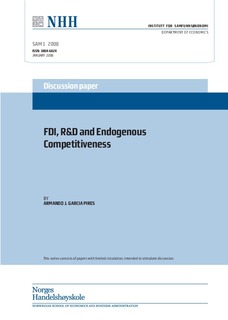| dc.contributor.author | Pires, Armando José Garcia | |
| dc.date.accessioned | 2008-08-27T13:20:09Z | |
| dc.date.available | 2008-08-27T13:20:09Z | |
| dc.date.issued | 2008-01 | |
| dc.identifier.issn | 0804-6824 | |
| dc.identifier.uri | http://hdl.handle.net/11250/163096 | |
| dc.description.abstract | We analyze the influence of endogenous competitiveness on multinational activity. Competitiveness is endogenized by assuming that
firms differ on R&D commitment power, i.e.: some firms are leaders
in R&D. We show that firms with higher commitment power tend to
invest more in R&D and consequently also tend to be more competitive than rivals that lack such capability. As a result, firms with higher
commitment power have higher propensity to become multinationals
than firms with lower commitment power. In addition, the former
use the R&D leader advantage to compel the latter to not enter the
market or, in case of entry, to force them to adopt the domestic strategy. Therefore, in addition to the proximity-concentration trade-off,
we identify another FDI determinant: strategic technological competitiveness. | en |
| dc.language.iso | eng | en |
| dc.publisher | Norwegian School of Economics and Business Administration. Department of Economics | en |
| dc.relation.ispartofseries | Discussion paper | en |
| dc.relation.ispartofseries | 2008:1 | en |
| dc.subject | market structure | en |
| dc.subject | R & D investment | en |
| dc.subject | multinationals | en |
| dc.subject | endogenous asymmetric firms | en |
| dc.title | FDI, R&D and endogenous competitiveness | en |
| dc.type | Working paper | en |
| dc.subject.nsi | VDP::Samfunnsvitenskap: 200::Økonomi: 210::Samfunnsøkonomi: 212 | en |
